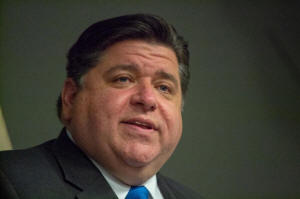Pritzker talks plans for Unemployment Trust Fund, pandemic response
 Send a link to a friend
Send a link to a friend
[July 23, 2021]
By JERRY NOWICKI
Capitol News Illinois
jnowicki@capitolnewsillinois.com
 SPRINGFIELD – Gov. JB Pritzker isn’t
considering using federal American Rescue Plan Act funding to pay down a
multi-billion-dollar Unemployment Insurance Trust Fund deficit, and he’s
watching the state’s COVID-19 hospitalization numbers closely. SPRINGFIELD – Gov. JB Pritzker isn’t
considering using federal American Rescue Plan Act funding to pay down a
multi-billion-dollar Unemployment Insurance Trust Fund deficit, and he’s
watching the state’s COVID-19 hospitalization numbers closely.
Those were two of the topics discussed during a 10-minute interview with
Capitol News Illinois on Wednesday as part of a two-day media tour held
by Pritzker after his Monday announcement that he was seeking reelection
in 2022.
The reason Pritzker won’t consider using federal ARPA funds on the $4.2
billion Trust Fund deficit, he said, is because he did not believe it a
permissible use of the funding, and he is hopeful that the federal
government will provide aid or rule changes to accommodate the 17 states
that have outstanding federal borrowing balances in their trust funds
amounting to $54 billion cumulatively.
“You can’t actually use ARPA funds according to the rules of ARPA. You
can't repay any debt that's already owed to the federal government,”
Pritzker said in the interview with CNI, citing the state’s initial plan
to repay pandemic related Municipal Liquidity Facility funding with the
ARPA funds – a use later ruled impermissible.

Interim U.S. Treasury rules for ARPA funding and the plans of dozens of
other states, however, contradict the governor’s statement on the use of
ARPA funds to repay the Unemployment Trust Fund deficit. The Associated
Press reported on May 27 that “at least 29 states already have
transferred or proposed to use a total of more than $12 billion of
federal coronavirus aid for their unemployment trust funds.”
Per the interim final rule, published May 17 in the Federal Register,
“recipients may make deposits into the state account of the Unemployment
Trust Fund … up to the level needed to restore the pre-pandemic balances
of such account as of January 27, 2020, or to pay back advances received
under Title XII of the Social Security Act.”
“States facing a sharp increase in Unemployment Insurance claims during
the pandemic may have drawn down positive Unemployment Trust Fund
balances and, after exhausting the balance, required advances to fund
continuing obligations to claimants,” the Treasury guidance reads.
“Because both of these impacts were driven directly by the need for
assistance to unemployed workers during the pandemic, replenishing
Unemployment Trust Funds up to the pre-pandemic level responds to the
pandemic’s negative economic impacts on unemployed workers.”
During a recent trip to Washington, D.C., Pritzker said, he spoke to
President Joe Biden and Illinois’ congressional leaders to seek further
federal assistance for the Trust Fund. He expounded Wednesday on what
changes might be possible.
“Some of this has to do with whether or not there could be legislation
that’s passed. And some of this is really changes in the rules that
could be made,” he said. “Certainly, if we could extend the due date of
the Trust Fund deficit to the federal government, that might be of
assistance to us. So we're looking at everything that's available to us,
because you know, all of us have the same goal, right, which is to get
that deficit down without it being a burden to businesses or to
workers.”

Business groups last week called on Pritzker to reinstate more stringent
work search requirements for Illinoisans who are on unemployment, to end
a $300 federal monthly payment to unemployed individuals earlier than
its September end date, and to infuse the Trust Fund with federal ARPA
dollars.
Each state has an Unemployment Insurance Trust Fund account maintained
by the U.S. Treasury but funded by the state’s businesses through
insurance premiums collected via payroll taxes. The rates at which
businesses pay into Illinois’ fund are determined by a complex statutory
formula.
[to top of second column]
|

Gov. JB Pritzker is pictured in a Capitol News
Illinois file photo.

The business community has warned that without a
solution to the Trust Fund deficit, premium rates on employers could
rise by the hundreds of millions, while unemployment benefits could
decrease in the hundreds of millions come January.
While use of the ARPA funding would have to be
approved by lawmakers, Pritzker’s administration and former
governors have generally been heavily involved in the negotiating
process on unemployment issues.
But Pritzker said he is hopeful federal action might come through
before that time period. Earlier this month, Illinois’ U.S. Sen.
Dick Durbin, a Democrat, said he expects Congress to begin debating
the next steps on unemployment as the current federal boost to
benefits ends in September.
“The question is, where will we be based upon the support that we
may get from the federal government and the reduction of the number
of people who are on unemployment? So we'll have to see where that
ends up,” Pritzker said Wednesday.
For his part, Pritzker said he has expanded child care availability
in an effort to encourage a return to the workforce and alleviate
stresses on the system.
“The biggest thing that's keeping many people from getting back to
work is the fact that they have to handle child care. Sometimes it's
senior care. People who stepped out of their jobs because they
needed to take care of somebody at home,” he said. “And so we've
expanded massively the availability of child care, particularly for
those up to $60,000 in earnings. …We now have available to people $1
a month child care, that's for people who are at the poverty level
and up to 250 percent of poverty level, people being able to pay
only 7 percent of their earnings. So that's a significant move
forward to help people get back to work.”

As for the pandemic, Pritzker said his medical advisers tell him the
main focus for monitoring disease spread should be intensive care
bed and hospital bed usage. But he has not set a concrete metric for
those numbers that would trigger another round of mitigations.
Those numbers were increasing statewide as of Wednesday night,
although they were still far off pandemic highs. There were 119 ICU
beds and 628 hospital beds in use by COVID-19 patients as of
Wednesday. The state’s 3 percent case positivity rate was a high
since May 7, five times its June 27 rate of 0.6 percent. The 1,993
new cases reported Thursday were a high since May 5.
“What I can tell you is getting people vaccinated is the most
important thing we can do right now, encouraging people to wear
masks when they're indoors in crowded areas, encouraging children
who are under 12 to wear masks when they go to school, ask parents
to have them wear masks when they go to school,” Pritzker said. “But
unvaccinated people make up 99% of all the deaths that are occurring
in the state of Illinois.”
Still, the governor said he wasn’t considering vaccine passport
requirements at this time.
Pritzker also touched on the state’s fiscal outlook and whether an
energy bill is likely to pass the General Assembly this year. You
can listen to the full interview on Capitol Cast here.
Capitol News Illinois is a nonprofit, nonpartisan
news service covering state government and distributed to more than
400 newspapers statewide. It is funded primarily by the Illinois
Press Foundation and the Robert R. McCormick Foundation. |